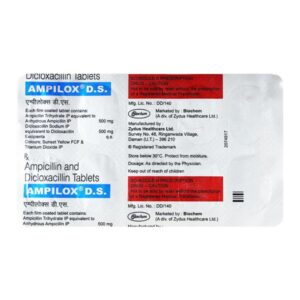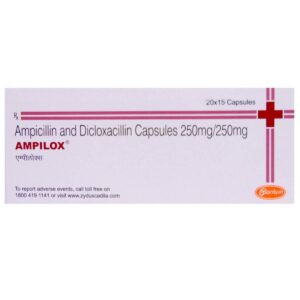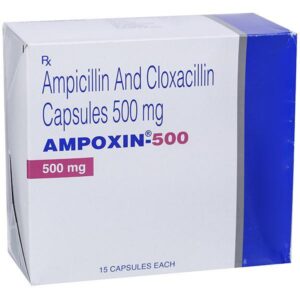AMPICILLIN + CLOXACILLIN
Ampicillin: Ampicillin is a broad-spectrum antibiotic drug that belongs to the penicillin class. It is commonly used to treat various bacterial infections, including respiratory tract infections, urinary tract infections, skin and soft tissue infections, gastrointestinal infections, and certain types of meningitis.
The main mechanism of action of ampicillin is to interfere with the synthesis of bacterial cell walls. It works by inhibiting the enzymes involved in the construction of the peptidoglycan layer, which is essential for the bacterial cell wall’s strength and integrity. By disrupting the cell wall synthesis, the drug weakens the bacteria, making them more susceptible to the body’s immune system. Ampicillin is effective against both gram-positive and gram-negative bacteria.
The dose of ampicillin may vary depending on the type and severity of the infection. It can be given orally or administered intravenously. The typical adult dose for mild to moderate infections is 250 to 500 mg every 6 hours. For more severe infections, the dose can be increased to 1 to 2 grams every 4 to 6 hours.
Like any medication, ampicillin can have side effects. Common side effects may include rash, diarrhea, nausea, and stomach pain. These are usually mild and resolve on their own. However, if severe diarrhea occurs or persists, it may be a sign of a more serious condition called pseudomembranous colitis, which requires medical attention. Some individuals may also be allergic to ampicillin, which can lead to allergic reactions such as itching, hives, swelling, or difficulty breathing. In severe cases, an allergic reaction can lead to anaphylaxis, which is a medical emergency. It is important to inform a healthcare provider about any known allergies before taking ampicillin.
Cloxacillin: Cloxacillin is a semi-synthetic penicillin antibiotic used predominantly to treat bacterial infections caused by susceptible organisms. It belongs to a class of antibiotics called beta-lactamase-resistant penicillins.
Cloxacillin works by inhibiting the synthesis of bacterial cell walls, leading to the disruption of the bacterial growth and subsequent killing of the bacteria. It is specifically effective against gram-positive bacteria, including Staphylococcus aureus strains that produce beta-lactamase.
It is primarily used to treat skin and soft tissue infections, such as cellulitis, impetigo, and abscesses caused by susceptible organisms. It is also used in respiratory tract infections, bone and joint infections, and certain types of endocarditis.
The dosage of cloxacillin varies depending on the severity of the infection. The usual adult oral dose ranges from 250 mg to 500 mg every 6 hours. For severe infections, the dosage may be doubled. For intravenous administration, the usual adult dose ranges from 500 mg to 2 grams every 4 to 6 hours.
Like other antibiotics, cloxacillin may cause some side effects. Common side effects include gastrointestinal disturbances such as nausea, vomiting, diarrhea, and abdominal pain. Skin rashes and allergic reactions are possible, although severe allergies are rare. Cloxacillin can also cause liver toxicity in rare cases, leading to elevated liver enzymes and jaundice. Other rare side effects include blood disorders, kidney damage, and hypersensitivity reactions.
It is important to note that cloxacillin is only effective against bacterial infections and does not work against viral infections such as the common cold or flu. Additionally, it is essential to complete the full course of treatment prescribed by a healthcare professional, even if symptoms improve before the completion of the antibiotic course.




